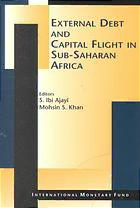
External debt and capital flight in Sub-Saharan Africa PDF
Preview External debt and capital flight in Sub-Saharan Africa
EXTERNAL DEBT AND CAPITAL FLIGHT IN SUB-SAHARAN AFRICA Editors S. Ibi Ajayi Mohsin S. Khan IMF Institute International Monetary Fund Washington, D.C. © 2000 International Monetary Fund Production: IMF Graphics Section Cover design: In-Ok Yoon Typesetting: Alicia Etchebarne-Bourdin Cataloging-in-Publication Data External debt and capital flight in Sub-Saharan Africa / S. Ibi Ajayi, Mohsin S. Khan, editors. — Washington, D.C. : Interna- tional Monetary Fund, IMF Institute, 2000. p. ; cm. Includes bibliographical references. ISBN 1-55775-791-7 1. Debts, External — Africa, Sub-Saharan. 2. Capital move- ments — Africa, Sub-Saharan. I. Ajayi, Simeon Ibidayo. II. Khan, Mohsin S. III. IMF Institute. HJ8826.E98 2000 Price: $26.00 Address orders to: International Monetary Fund, Publication Services 700 19th Street, N.W., Washington, D.C., 20431, U.S.A. Tel: (202) 623-7430 Telefax: (202) 623-7201 E-mail: [email protected] Internet: http://www.imf.org EXTERNAL DEBT AND CAPITAL FLIGHT IN SUB-SAHARAN AFRICA This page intentionally left blank Contents Preface vii 1. Introduction S. Ibi Ajayi and Mohsin S. Khan 1 Part I External Debt 2. Macroeconomic Approach to External Debt: The Case of Nigeria S. Ibi Ajayi 11 3. Ghana: The Burden of Debt-Service Payment Under Structural Adjustment Barfour Osei 57 4. Growth and Foreign Debt: The Ugandan Experience Barbara Mbire Barungi and Michael Atingi 93 5. The External Debt Problem of Kenya N.K Ng'eno 128 6. An Econometric Analysis of External Debt and Economic Growth in Sub-Saharan African Countries Milton A. Iyoha 160 Part II Capital Flight 7. Capital Flight and External Debt in Nigeria S. Ibi Ajayi 213 8. Capital Flight from Uganda, 1997-94 Razaq A. Olopoenia 238 9. Capital Flight from Tanzania Timothy S. Nyoni 265 10. Capital Flight in Kenya N.K. Ng'eno 300 Contributors 321 v This page intentionally left blank Preface The economic problems afflicting Africa in general are many and varied. Among these, the twin problems of mounting external debt and large-scale capital flight have been at the forefront since at least the 1980s. The papers in this volume analyze these problems for a se- lected group of sub-Saharan African countries. All the studies were sponsored by the African Economic Research Consortium (AERC) in the period 1989-97. The various analyses of the different countries are brought together here to highlight common themes, and to compare and contrast the experiences of different countries. The issues raised in these papers still remain relevant to the countries today, and indeed apply to many other African countries as well. The AERC commissioned us to put the papers together in a book in 1997. It is our hope that the materials in the book will serve not only as good reference points for the generation of scholars working in the areas of external debt and capital flight in sub-Saharan Africa, but also to policy analysts and policymakers as well. Our special thanks go to the former Executive Director of AERC, Professor Benno Ndulu and the former AERC Director of Research, Dr. Ibrahim Elbadawi for initi- ating the idea of this book and their subsequent support for the pro- ject. Special thanks also go to the International Monetary Fund for ac- cepting to publish the book as a service for its member countries. S. Vox Ajayi Mohsin S. Khan VII This page intentionally left blank 1 Introduction 5. Ibi Ajayi and Mohsin 5. Khan It is generally expected that developing countries, facing a scarcity of capital, will acquire external debt to supplement domestic saving. The rate at which they borrow abroad—the "sustainable" level of for- eign borrowing—depends on the links among foreign and domestic saving, investment, and economic growth. The main lesson of the stan- dard "growth with debt" literature is that a country should borrow abroad as long as the capital thus acquired produces a rate of return that is higher than the cost of the foreign borrowing. In that event, the borrowing country is increasing capacity and expanding output with the aid of foreign savings. In theory, it is possible to calculate the sustainable level of foreign borrowing, based, for example, on the terms, maturity, and availabil- ity of foreign capital. In practice, however, the task is nearly impossi- ble, since such information is not readily available. Thus, various ra- tios, such as that of debt to exports, debt service to exports, and debt to GDP (or GNP), have become standard measures of sustainability. Even though it is difficult to determine the sustainable level of such ratios, their chief practical value is to warn of potentially explosive growth in the stock of foreign debt. If additional foreign borrowing in- creases the debt-service burden more than it increases the country's ca- pacity to carry that burden, the situation must be reversed by expand- ing exports. If it is not, and conditions do not change, more borrowing will be needed to make payments, and external debt will grow faster than the country's capacity to service it. Countries in sub-Saharan Africa have generally adopted a develop- ment strategy that relies heavily on foreign financing from both official and private sources. Unfortunately, this has meant that for many coun- tries in the region the stock of external debt has built up over recent decades to a level that is widely viewed as unsustainable. For example, in 1975 the external debt of sub-Saharan Africa amounted to about $18 billion. By 1995, however, the stock of debt had risen to over $220 bil- lion. The standard ratios reflect this huge buildup of debt. The region's aggregate debt-export ratio rose from 51 percent in 1975 to about 270 percent in 1995 (excluding South Africa, the ratio was above 300 per- cent). For all low- and middle-income developing countries, the aver- 1
